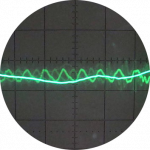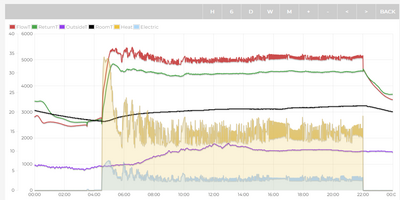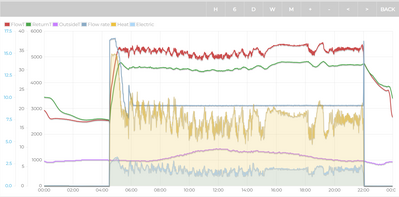@pooneil That can be moved quite easily into another room if necessary. Mine acts as a limiter in case the room gets too hot because of solar gain and also stops the heat pump cycling too much in very mild weather at low flow temperatures.
Will be interested to hear how it goes today with the changes you have made. I have a limit on how low I can take my flow temperature on the WC curve caused by the size of my radiators.
House-2 bed partial stone bungalow, 5kW Samsung Gen 6 ASHP (Self install)
6.9 kWp of PV
5kWh DC coupled battery
Blog: https://thegreeningofrosecottage.weebly.com/
Heatpump Stats: http://heatpumpmonitor.org/system/view?id=60
This morning it's reading 20°. But what is measuring that number? Because if it's that controller unit on the tank, that is in a cupboard in the unheated utility, which I would guess is at least a couple of degrees lower than the house, which still feels uncomfortably hot, especially now in the bedrooms with the TRVs open. I certainly wouldn't be able to sleep in that temp.
Is there a way to move the controller wirelessly?
The thing I'm having trouble understanding is why the heating cycle wants to come on when there's a tank of hot water and it's +20° in the house. If I'm understanding the installer correctly, it's measuring the outside temp and supplying heat based on that, is that correct?
If so that makes no sense to me because it couldn't possibly know how much heat is being lost through the fabric of the house.
@bontwoody I have been looking at your graphs on emoncms. Could you explain how you are controlling the water pump? It seems to be running at a constant 8.9 l/min except, when a new cycle starts, there is a big spike in both pump speed and HP power output. There is no graph of room temperature, so what swing are you getting (if any) of room temperature?
Private individual. No affiliation with commercial "Heat Geeks" of same coincidental name.
I assume that's directed at me rather than bontwoody 🙂
I don't really understand what you are asking. I personally don't know how the water pump is controlled. The radiators seem to be constantly warm -- unless TRVs are turned down, and I'm only popping in to check every now and then.
@pooneil Unfortunately the controller is wired with a two wire cable. It is measuring your internal temperature so if its in a cupboard, thats not ideal.
If its too hot then I would lower the WC set points again and see how that goes. As I said its a bit of trial and error, ideally done on a very warm and very cold day to get you outlying flow temperatures right. All you need to do is match the heat loss of the house with heat input and that is determined from the flow temperature.
Domestic Hot Water heating and room heating are totally separate. Its one or the other not both at once and they use very different flow temperatures. You should have a schedule set up to do the DHW.
House-2 bed partial stone bungalow, 5kW Samsung Gen 6 ASHP (Self install)
6.9 kWp of PV
5kWh DC coupled battery
Blog: https://thegreeningofrosecottage.weebly.com/
Heatpump Stats: http://heatpumpmonitor.org/system/view?id=60
Posted by: @pooneil
The thing I'm having trouble understanding is why the heating cycle wants to come on when there's a tank of hot water and it's +20° in the house. If I'm understanding the installer correctly, it's measuring the outside temp and supplying heat based on that, is that correct?
If so that makes no sense to me because
The answer to the first question will (hopefully) be because its cold outside and the heat pump is (effectively) preparing for the effect of the cold outside on the house (which responds slowly so it needs to prepare in advance).
The heat pump does know pretty well how much heat is being lost through the fabric of the house, because this is proportional to inside temperature - outside temperature (ignoring solar gain).
The whole principle of weather compensation is to measure the outside temperature and supply heat dependent on this figure, on the assumption that you want a constant inside temperature. The advantage of this over simply measuring inside temperature is twofold namely
- If correctly adjusted it ensures the lowest possible flow temperature consistent with heating the house = greatest efficiency and greatest comfort
- Because outside temperature is a leading indicator, unlike inside temperature which is a lagging indicator, it makes for a more stable and more reactive control loop (there is a whole branch of engineering called 'control theory' behind this statement)
Weather compensation is not unique to heat pumps, boilers also have it. For some (suspect) reason known only to plumbers we don't typically enable it in this country, but others do and in some, more enlightened, countries its been mandatory for many years. As a consequence of our decision not to enable WC on boilers we have, since the introduction of condensing boilers, typically paid ~10% more for our heating than we needed to , and 'enjoyed' poorer comfort as a result.
To make weather compensation work (and it does work) you need to follow this procedure to adjust your WC settings, ideally when its consistently cold outside (ie now isnt the best time to do it, so you can start now but may need to revisit in winter)
1. Set all your TRVs and thermostats to max
2. Set your heat pump to run 24x7
3. Ensure your controller is set to run on pure water law
4. Adjust the high OAT end of the WC curve to (something like) OAT 20, FT 27
5. Slowly adjust the programmed FT at the low OAT end downwards until the house is just at the right temperature, making changes of a degree once per day (you can start faster and slow down as you approach the right value)
If rooms end up at different temperatures you may have to balance the radiators.
This procedure adjusts the WC to be as low as possible while heating your house, which is (more or less) the most efficient operating point for a heat pump
Once you have done this you can, if you need to, reinstate TRVs or the temperature sensor in the controller acting as temperature limiters (but not temperature controllers), particularly in rooms where there is solar gain. You can do various other tweaks if the above doesn't work perfectly in your house (in many it will work very well, in some it will generally work well but can be tweaked to make it even better). In all cases the above adjustment is the starting point
Essentially this is a long form version of what @bontwoody has advised above
4kW peak of solar PV since 2011; EV and a 1930s house which has been partially renovated to improve its efficiency. 7kW Vaillant heat pump.
@heatgeek Hi, its run on pure WC, open loop system with a PWM controlled pump. The controller is in the living room and set to stop the heat pump if the room overheats.
Here is a graph showing room temperature
House-2 bed partial stone bungalow, 5kW Samsung Gen 6 ASHP (Self install)
6.9 kWp of PV
5kWh DC coupled battery
Blog: https://thegreeningofrosecottage.weebly.com/
Heatpump Stats: http://heatpumpmonitor.org/system/view?id=60
@bontwoody I understood that the Samsung Gen 6 does not have PWM pump control so your system is not a simple, straight-forward installation. You have a third-party PWM controller?
Private individual. No affiliation with commercial "Heat Geeks" of same coincidental name.
@heatgeek No. I can confirm it does have the facility for PWM control. Just an appropriate pump and a lead is needed
House-2 bed partial stone bungalow, 5kW Samsung Gen 6 ASHP (Self install)
6.9 kWp of PV
5kWh DC coupled battery
Blog: https://thegreeningofrosecottage.weebly.com/
Heatpump Stats: http://heatpumpmonitor.org/system/view?id=60
@bontwoody Interesting. Thanks. This explains your steady DT control.
Private individual. No affiliation with commercial "Heat Geeks" of same coincidental name.
@bontwoody Your Samsung Gen 6 has interesting behaviour which is different to the stereotypical belief. It boosts output at the beginning of the cycle to get temperature up quickly and then settles into a relatively constant flow (blue line in diagram). In the diagram it is modulating heat output from below 2kW to around 3kW but it does this by changing the DT interestingly. Popular belief would have it that the Samsung would modulate the flow and maintain a steady 5C DT. This is taxing my brain.🤨
Private individual. No affiliation with commercial "Heat Geeks" of same coincidental name.
- 26 Forums
- 2,342 Topics
- 53 K Posts
- 189 Online
- 6,000 Members
Join Us!
Worth Watching
Latest Posts
-
RE: Configuration issues with 10kW Midea R32 heat pump
Not that I know of. It’s a regular complaint with respe...
By benson , 2 minutes ago
-
RE: Poll for Time of Use, tariffs, technology
Typo... of course Max charge/discharge rate is 2600kWh....
By Tim441 , 4 minutes ago
-

@majordennisbloodnok it isn't obvious where on their si...
By Morgan , 8 minutes ago
-
RE: 10kw heat pump run in 24*7 data?
I would say you most likely do need 10kW. My gas consu...
By JamesPa , 20 minutes ago
-

RE: Has Anyone Else Noticed a Decline in Tradesmanship?
Purely subjectively, I think the proportion of cowboys ...
By Majordennisbloodnok , 40 minutes ago
-

Of the various solar PV forecasting services, Solcast s...
By Majordennisbloodnok , 50 minutes ago
-

-

RE: Heat Pump Performance Analysis Web App using Modbus Data
@redzer_irl ok. Thanks I will have a look when ive got ...
By bontwoody , 2 hours ago
-
RE: Here is my heat pump installation with questionable COP in Italy
Well in Italy there is nothing controlling the quality ...
By materox345 , 2 hours ago
-

RE: What a Bad Heat Pump Installation Looks Like
@editor The trick to an inside unit installation is to ...
By MikeFl , 17 hours ago
-
RE: Different dT on each radiator?
The way heating systems are designed will result in rou...
By JamesPa , 19 hours ago
-

RE: Setback savings - fact or fiction?
PS by visually merging the two tables as above, I ended...
By cathodeRay , 1 day ago
-

RE: Homely for Daikin Altherma 3 - Petersfield Area
@russ If you would care to pose your questions on one o...
By Toodles , 1 day ago
-

RE: The good, the bad and the not that great – my heat pump installation
@cathoderay the guy I spoke to on the phone seemed very...
By Burtis , 2 days ago
-
RE: British Gas vs Octopus Energy vs Heat Geek vs EDF vs Aira vs OVO vs EON.Next vs Boxt
I get the impression that that comment "they don't comm...
By JamesPa , 2 days ago
-

@majordennisbloodnok Just in case there are variations ...
By Toodles , 2 days ago
-

RE: Latest NIBE model has known defect and no solution
@kings I’m glad I could help. NIBE are taking this very...
By Mars , 2 days ago
-
RE: Octopus Cosy Heat Pump Owners & Discussion Thread
@jamespa yes, I'm under no illusions but in some respec...
By AndrewJ , 2 days ago
-
RE: Electricity price predictions
It seems the end of cfd payments is in sight, even if a...
By Batpred , 2 days ago








